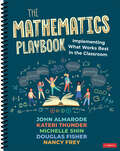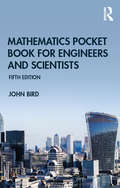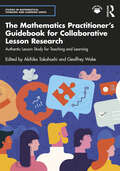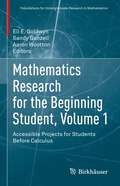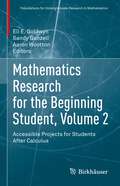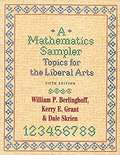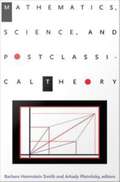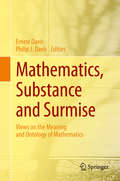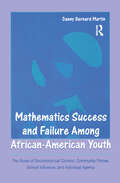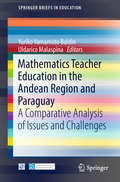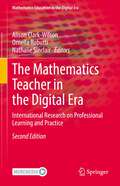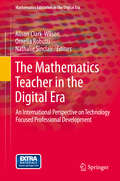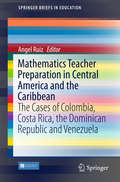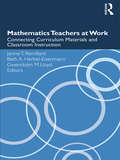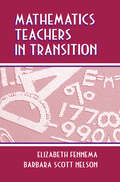- Table View
- List View
The Mathematics Playbook: Implementing What Works Best in the Classroom
by John T. Almarode Kateri Thunder Michelle Shin Douglas Fisher Nancy FreyYour Guide to Engaging and Effective Math Instruction With the latest research on what works best in teaching and learning, The Mathematics Playbook is your comprehensive guide to enhancing mathematics teaching and learning. With a focus on fostering equity and maximizing student learning, the authors provide practical modules that integrate the latest research on effective teaching practices, and answer four critical questions: How do we foster, nurture, and sustain mathematics learning? How do we ensure all learners have equity of access and opportunity? What are the non-negotiables in a high-quality mathematics task? How do we know if learners really "get it"? Through real-life examples and an emphasis on self-assessment and reflection, this playbook empowers you to create engaging and impactful learning experiences in mathematics.
Mathematics Pocket Book for Engineers and Scientists (Routledge Pocket Books)
by John BirdThis compendium of essential formulae, definitions, tables and general information provides the mathematical information required by engineering students, technicians, scientists and professionals in day-to-day engineering practice. A practical and versatile reference source, now in its fifth edition, the layout has been changed and streamlined to ensure the information is even more quickly and readily available – making it a handy companion on-site, in the office as well as for academic study. It also acts as a practical revision guide for those undertaking degree courses in engineering and science, and for BTEC Nationals, Higher Nationals and NVQs, where mathematics is an underpinning requirement of the course. All the essentials of engineering mathematics – from algebra, geometry and trigonometry to logic circuits, differential equations and probability – are covered, with clear and succinct explanations and illustrated with over 300 line drawings and 500 worked examples based in real-world application. The emphasis throughout the book is on providing the practical tools needed to solve mathematical problems quickly and efficiently in engineering contexts. John Bird’s presentation of this core material puts all the answers at your fingertips.
Mathematics Practice and Problem Solving [Grade] 3 (Ready North Carolina)
by Sarah Kraus David PolakoffNIMAC-sourced textbook
The Mathematics Practitioner’s Guidebook for Collaborative Lesson Research: Authentic Lesson Study for Teaching and Learning (Studies in Mathematical Thinking and Learning Series)
by Akihiko Takahashi Geoffrey WakeThis resource provides mathematics educators with tools for conducting Collaborative Lesson Research (CLR), a form of Lesson Study developed out of the original Japanese Lesson Study and intended to improve student and teacher learning. Renowned mathematics education researchers Akihiko Takahashi and Geoffrey Wake bring together educators across the US and UK with first-hand experience using CLR in their schools. Readers will learn the essentials for an impactful Lesson Study directly from the scholars who coined the term, and benefit from the dual perspectives of math education researchers and teachers who have used CLR when reflecting on their own classroom pedagogy. These contributors define CLR and provide examples of successful CLR using real-life case studies, as well as introducing pathways for getting started and practical suggestions for implementation into different school environments. Across these examples, readers will: understand the essence of Lesson Study, considered as CLR, and its important features be advised what participants in CLR should expect to do (observing research lessons, designing lessons, teaching research lessons, facilitating post-lesson discussion, etc.) and provide guidance and support with this enactment be advised on how to develop, embed, and sustain CLR communities preview potential outcomes over time from undertaking CLR Research lesson proposals and plans to support readers in understanding CLR are also included. Ideal for practicing teachers, teacher leaders, teacher educators, and professional developers involved in mathematics teaching, this book offers first-of-its-kind entry points for CLR. Its combination of theory and practice will empower educators to implement this increasingly popular vehicle for understanding students’ learning of mathematics.
Mathematics Research for the Beginning Student, Volume 1: Accessible Projects for Students Before Calculus (Foundations for Undergraduate Research in Mathematics)
by Eli E. Goldwyn Sandy Ganzell Aaron WoottonMathematics research opportunities for undergraduate students have grown significantly in recent years, but accessible research topics for first- and second-year students with minimal experience beyond high school mathematics are still hard to find. To address this need, this volume provides beginning students with specific research projects and the tools required to tackle them. Most of these projects are accessible to students who have not yet taken Calculus, but students who know some Calculus will find plenty to do here as well. Chapters are self-contained, presenting projects students can pursue, along with essential background material and suggestions for further reading. Suggested prerequisites are noted at the beginning of each chapter. Some topics covered include:games on graphsmodeling of biological systemsmosaics and virtual knotsmathematics for sustainable humanitymathematical epidemiologyMathematics Research for the Beginning Student, Volume 1 will appeal to undergraduate students at two- and four-year colleges who are interested in pursuing mathematics research projects. Faculty members interested in serving as advisors to these students will find ideas and guidance as well. This volume will also be of interest to advanced high school students interested in exploring mathematics research for the first time. A separate volume with research projects for students who have already studied calculus is also available.
Mathematics Research for the Beginning Student, Volume 2: Accessible Projects for Students After Calculus (Foundations for Undergraduate Research in Mathematics)
by Eli E. Goldwyn Sandy Ganzell Aaron WoottonMathematics research opportunities for undergraduate students have grown significantly in recent years, but accessible research topics for first- and second-year students are still hard to find. To address this need, this volume provides beginning students who have already had some exposure to calculus with specific research projects and the tools required to tackle them. Chapters are self-contained, presenting projects students can pursue, along with essential background material and suggestions for further reading. In addition to calculus, some of the later chapters require prerequisites such as linear algebra and statistics. Suggested prerequisites are noted at the beginning of each chapter. Some topics covered include:lattice walks in the planestatistical modeling of survival databuilding blocks and geometrymodeling of weather and climate changemathematics of risk and insuranceMathematics Research for the Beginning Student, Volume 2 will appeal to undergraduate students at two- and four-year colleges who are interested in pursuing mathematics research projects. Faculty members interested in serving as advisors to these students will find ideas and guidance as well. This volume will also be of interest to advanced high school students interested in exploring mathematics research for the first time. A separate volume with research projects for students who have not yet studied calculus is also available.
A Mathematics Sampler: Topics for the Liberal Arts
by William P. Berlinghoff Kerry E. Grant Dale SkrienNow in its fifth edition, A Mathematics Sampler presents mathematics as both science and art, focusing on the historical role of mathematics in our culture. It uses selected topics from modern mathematics—including computers, perfect numbers, and four-dimensional geometry—to exemplify the distinctive features of mathematics as an intellectual endeavor, a problem-solving tool, and a way of thinking about the rapidly changing world in which we live. <p><p> A Mathematics Sampler also includes unique LINK sections throughout the book, each of which connects mathematical concepts with areas of interest throughout the humanities. The original course on which this text is based was cited as an innovative approach to liberal arts mathematics in Lynne Cheney's report, "50 HOURS: A Core Curriculum for College Students", published by the National Endowment for the Humanities.
Mathematics, Science, and Postclassical Theory
by Barbara Herrnstein Smith Arkady PlotnitskyMathematics, Science, and Postclassical Theory is a unique collection of essays dealing with the intersections between science and mathematics and the radical reconceptions of knowledge, language, proof, truth, and reality currently emerging from poststructuralist literary theory, constructivist history and sociology of science, and related work in contemporary philosophy. Featuring a distinguished group of international contributors, this volume engages themes and issues central to current theoretical debates in virtually all disciplines: agency, causality, determinacy, representation, and the social dynamics of knowledge. In a substantive introductory essay, the editors explain the notion of "postclassical theory" and discuss the significance of ideas such as emergence and undecidability in current work in and on science and mathematics. Other essays include a witty examination of the relations among mathematical thinking, writing, and the technologies of virtual reality; an essay that reconstructs the conceptual practices that led to a crucial mathematical discovery--or construction--in the 19th century; a discussion of the implications of Bohr's complementarity principle for classical ideas of reality; an examination of scientific laboratories as "hybrid" communities of humans and nonhumans; an analysis of metaphors of control, purpose, and necessity in contemporary biology; an exploration of truth and lies, and the play of words and numbers in Shakespeare, Frege, Wittgenstein, and Beckett; and a final chapter on recent engagements, or nonengagements, between rationalist/realist philosophy of science and contemporary science studies. Contributors. Malcolm Ashmore, Michel Callon, Owen Flanagan, John Law, Susan Oyama, Andrew Pickering, Arkady Plotnitsky, Brian Rotman, Barbara Herrnstein Smith, John Vignaux Smyth, E. Roy Weintraub
Mathematics, Substance and Surmise
by Ernest Davis Philip J. DavisThe seventeen thought-provoking and engaging essays in this collection present readers with a wide range of diverse perspectives on the ontology of mathematics. The essays address such questions as: What kind of things are mathematical objects? What kinds of assertions do mathematical statements make? How do people think and speak about mathematics? How does society use mathematics? How have our answers to these questions changed over the last two millennia, and how might they change again in the future? The authors include mathematicians, philosophers, computer scientists, cognitive psychologists, sociologists, educators and mathematical historians; each brings their own expertise and insights to the discussion. Contributors to this volume: Jeremy Avigad Jody Azzouni David H. Bailey David Berlinski Jonathan M. Borwein Ernest Davis Philip J. Davis Donald Gillies Jeremy Gray Jesper Lützen Ursula Martin Kay O'Halloran Alison Pease Steven Piantadosi Lance Rips Micah T. Ross Nathalie Sinclair John Stillwell Hellen Verran
Mathematics Success and Failure Among African-American Youth: The Roles of Sociohistorical Context, Community Forces, School Influence, and Individual Agency (Studies in Mathematical Thinking and Learning Series)
by Danny Bernard MartinNo matter how mathematics achievement and persistence are measured, African Americans seem to lag behind their peers. This state of affairs is typically explained in terms of student ability, family background, differential treatment by teachers, and biased curricula. But what can explain disproportionately poor performance and persistence of African-American students who clearly possess the ability to do well, who come from varied family and socioeconomic backgrounds, who are taught by caring and concerned teachers, and who learn mathematics in the context of a reform-oriented mathematics curriculum? And, why do some African-American students succeed in mathematics when underachievement is the norm among their fellow students? Danny Martin addresses these questions in Mathematics Success and Failure Among African-American Youth, the results of a year-long ethnographic and observational study of African-American students and their parents and teachers. Mathematics Success and Failure Among African-American Youth goes beyond the conventional explanations of ability, socioeconomic status, differential treatment, and biased curricula to consider the effects of history, community, and peers--and the individual agency that allows some students to succeed despite these influences. Martin's analysis suggests that prior studies of mathematics achievement and persistence among African Americans have failed to link sociohistorical, community, school, and intrapersonal forces in sufficiently meaningful ways, and that they suffer from theoretical and methodological limitations that hinder the ability of mathematics educators to reverse the negative achievement and persistence trends that continue to afflict African-American students. The analyses and findings offered in Martin's book lead to exciting implications for future research and intervention efforts concerning African-American students--and other students for whom history and context play an important role. This book will be useful and informative to many groups: mathematics education researchers, education researchers interested in the social context of learning and teaching, policymakers, preservice and in-service teachers, students, parents, and community advocates. It will also be of interest to readers concerned with multicultural education, cross-cultural studies of mathematics learning, sociology of education, Black Studies, and issues of underrepresentation in science and mathematics.
Mathematics Teacher Education in the Andean Region and Paraguay: A Comparative Analysis of Issues and Challenges (SpringerBriefs in Education)
by Uldarico Malaspina Yuriko Yamamoto Baldin Jill AdlerThis book is an excellent synthesis of the initial and continuing preparation for Mathematics Teaching in Bolivia, Ecuador, Paraguay and Peru, from which comparative analyses can be made that show similarities and differences, and highlight various perspectives. In February 2016, the 5th Capacity and Networking Project (CANP) workshop of the International Commission on Mathematical Instruction (ICMI) was held in Lima, Peru. The coordination of this two-week workshop was undertaken by an international scientific committee (IPC), with equal participation by mathematicians and mathematics educators from the region and from the international ICMI and IMU community. The goal of CANP5 was to improve the quality of mathematics education in the region, which led to the main theme of the scientific program “Initial and Continued Teacher Education”. Country Reports on the main theme of teacher education systems for each country in this region were presented and discussed to detect common issues that might be improved through a collaborative network. One of the most important results of this event was the creation of a Mathematics Education Network, namely the Comunidad de Educación Matemática de America del Sur – CEMAS. This book brings to the international Educational Community an important collection of experiences and ideas in the Mathematics Education of four Latin-American countries in the developing Andean region and Paraguay. The dissemination of these results can promote the search for international collaborative actions in a wider scale.
The Mathematics Teacher in the Digital Era: International Research on Professional Learning and Practice (Mathematics Education in the Digital Era #16)
by Alison Clark-Wilson Ornella Robutti Nathalie SinclairThis book brings together international research on school teachers’, and university lecturers’ uses of digital technology to enhance teaching and learning in mathematics. It includes contributions that address theoretical, methodological, and practical challenges for the field with the research lens trained on the perspectives of teachers and teaching. As countries around the world move to integrate digital technologies in classrooms, this book collates research perspectives and experiences that offer valuable insights, in particular concerning the trajectories of development of teachers’ digital skills, knowledge and classroom practices.Via app: download the SN More Media app for free, scan a link with play button and access the videos directly on your smartphone or tablet.
The Mathematics Teacher in the Digital Era: An International Perspective on Technology Focused Professional Development (Mathematics Education in the Digital Era #2)
by Nathalie Sinclair Alison Clark-Wilson Ornella RobuttiThis volume addresses the key issue of the initial education and lifelong professional learning of teachers of mathematics to enable them to realize the affordances of educational technology for mathematics. With invited contributions from leading scholars in the field, this volume contains a blend of research articles and descriptive texts.In the opening chapter John Mason invites the reader to engage in a number of mathematics tasks that highlight important features of technology-mediated mathematical activity. This is followed by three main sections:An overview of current practices in teachers’ use of digital technologies in the classroom and explorations of the possibilities for developing more effective practices drawing on a range of research perspectives (including grounded theory, enactivism and Valsiner’s zone theory).A set of chapters that share many common constructs (such as instrumental orchestration, instrumental distance and double instrumental genesis) and research settings that have emerged from the French research community, but have also been taken up by other colleagues.Meta-level considerations of research in the domain by contrasting different approaches and proposing connecting or uniting elements
Mathematics Teacher Preparation in Central America and the Caribbean: The Cases of Colombia, Costa Rica, the Dominican Republic and Venezuela (SpringerBriefs in Education)
by Angel RuizThis Open Access book is an excellent synthesis of the initial and continuing preparation for Mathematics Teaching in Colombia, Costa Rica, Dominican Republic and Venezuela, from which comparative analyses can be made that show similarities and differences, and highlight various perspectives.In August 2012, a workshop of the Capacity and Networking Project (CANP) of the International Commission on Mathematical Instruction (ICMI) was held in Costa Rica. This CANP brought together for two weeks a group of 66 Mathematics educators, mathematicians, university administrators, and elementary and secondary teachers from Colombia, Venezuela, the Dominican Republic, Panamá and Costa Rica. The goal was to promote progress in Mathematics Education in the region; as such it was a unique experience in the region. One of the most important results of this event was the creation of the Mathematics Education Network of Central America and the Caribbean (REDUMATE). It was organized by persons associated with the Mathematics Education Reform Project in Costa Rica (responsible for the most outstanding and innovative curriculum reform in Latin America) and the Inter-American Committee on Mathematics Education (IACME), which is an official regional multinational organization affiliate of ICMI.This book brings to the international Educational Community an important collection of experiences and ideas in the Mathematics Education of four countries of a region within the heart of the American continent, a region that has been many times forgotten. The dissemination of these results can promote the search for international collaborative actions in a wider scale.
Mathematics Teachers at Work: Connecting Curriculum Materials and Classroom Instruction (Studies in Mathematical Thinking and Learning Series)
by Janine T. Remillard Beth A. Herbel-Eisenmann Gwendolyn M. LloydThis book compiles and synthesizes existing research on teachers’ use of mathematics curriculum materials and the impact of curriculum materials on teaching and teachers, with a particular emphasis on – but not restricted to – those materials developed in the 1990s in response to the NCTM’s Principles and Standards for School Mathematics. Despite the substantial amount of curriculum development activity over the last 15 years and growing scholarly interest in their use, the book represents the first compilation of research on teachers and mathematics curriculum materials and the first volume with this focus in any content area in several decades.
Mathematics Teachers in Transition (Studies in Mathematical Thinking and Learning Series)
by Elizabeth Fennema Barbara Scott NelsonThis book addresses the need of professional development leaders and policymakers for scholarly knowledge about influencing teachers to modify mathematical instruction to bring it more in alignment with the recommendations of the current reform movement initiated by the National Council of Teachers of Mathematics. The book presents: * theoretical perspectives for studying, analyzing, and understanding teacher change; * descriptions of contextual variables to be considered as one studies and attempts to understand teacher change; and * descriptions of professional development programs that resulted in teacher change. One chapter builds a rationale for looking to developmental psychology for guidance in constructing models of reconstructing new forms of mathematical instruction. Another highlights the relevance to mathematics teacher development of research-based knowledge about how children construct mathematical ideas. Other chapters explore the relationships between the various contexts of schooling and instructional change. Included also are chapters that describe and analyze major reform efforts designed to assist teachers in modifying their instructional practices (Cognitively Guided Instruction, Math-Cubed, Project Impact, Mathematics in Context, and the Case-Based Project). Finally, the current state of knowledge about encouraging teachers to modify their instruction is discussed, the implications of major research and implementation findings are suggested, and some of the major questions that need to be addressed are identified, such as what we have learned about teacher change.
